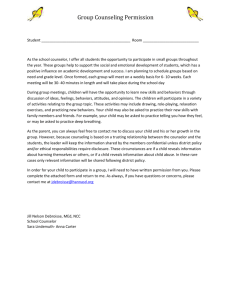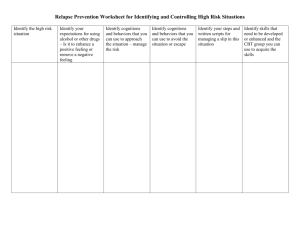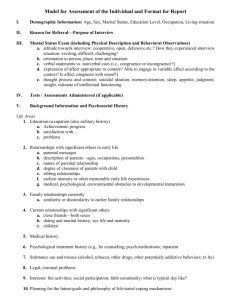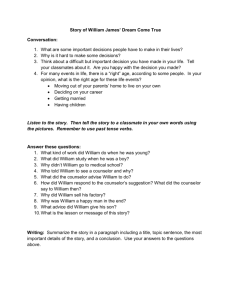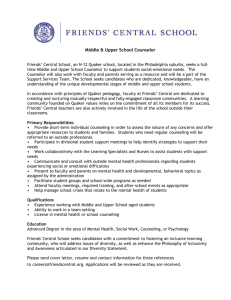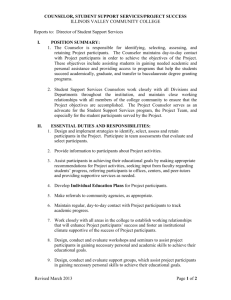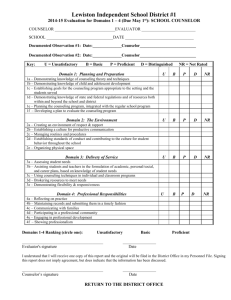WAYLAND BAPTIST UNIVERSITY FAIRBANKS CAMPUS School of
advertisement
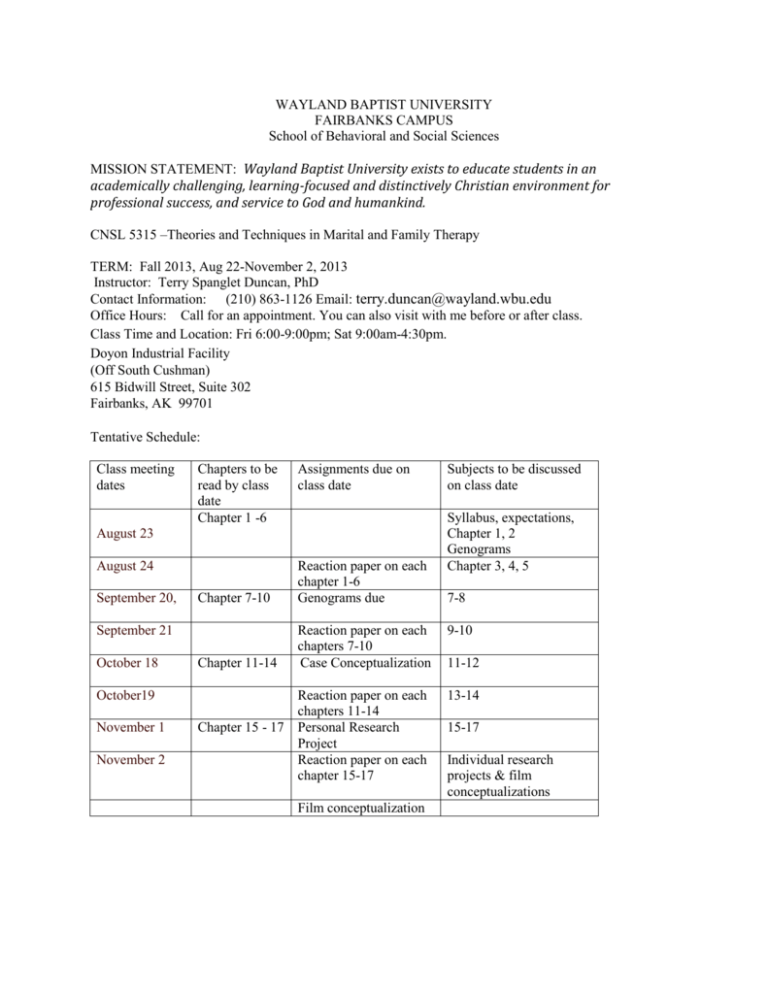
WAYLAND BAPTIST UNIVERSITY FAIRBANKS CAMPUS School of Behavioral and Social Sciences MISSION STATEMENT: Wayland Baptist University exists to educate students in an academically challenging, learning-focused and distinctively Christian environment for professional success, and service to God and humankind. CNSL 5315 –Theories and Techniques in Marital and Family Therapy TERM: Fall 2013, Aug 22-November 2, 2013 Instructor: Terry Spanglet Duncan, PhD Contact Information: (210) 863-1126 Email: terry.duncan@wayland.wbu.edu Office Hours: Call for an appointment. You can also visit with me before or after class. Class Time and Location: Fri 6:00-9:00pm; Sat 9:00am-4:30pm. Doyon Industrial Facility (Off South Cushman) 615 Bidwill Street, Suite 302 Fairbanks, AK 99701 Tentative Schedule: Class meeting dates Chapters to be read by class date Chapter 1 -6 Assignments due on class date August 23 August 24 Chapter 7-10 Reaction paper on each chapter 1-6 Genograms due October 18 Chapter 11-14 Reaction paper on each chapters 7-10 Case Conceptualization October19 Reaction paper on each chapters 11-14 Chapter 15 - 17 Personal Research Project Reaction paper on each chapter 15-17 September 20, September 21 November 1 November 2 Film conceptualization Subjects to be discussed on class date Syllabus, expectations, Chapter 1, 2 Genograms Chapter 3, 4, 5 7-8 9-10 11-12 13-14 15-17 Individual research projects & film conceptualizations Catalog Description: An examination of the field, including communication, structural, and systems theories. Practical aspects and experience with therapeutic techniques and strategies will be covered as well. Prerequisites: There is no prerequisite for this course Textbook: Family Therapy: An Overview 5th Edition by Goldenberg and Goldenberg (2013) ISBN-10: 1-111-82880-6 , My Family Story Workbook by Goldenberg and Goldenberg (Optional), Family Therapy Glossary AAMFT (Optional) Textbooks are an information source and a means of explaining and stimulating interest in the material. It does not contain all the information students need to know, however. Additional information, interpretations, and analyses will be given in class. Course outcome competencies: • For students to demonstrate critical thinking. • For students to demonstrate major psychological terms and concepts as related to Marriage and family counseling. • For students to demonstrate systemic and cognitive/ behavioral approaches to marriage and family counseling. • For students to be able to apply psychological terms, concepts, and theories regarding marriage and family counseling to three movies viewed in class. • For students to demonstrate PERSONAL RESPONSIBILITY AND COMMITMENT TO VALUES as practiced by honesty in class such as no cheating, and as shown by their discussion in class. Attendance: Students enrolled at one of the University’s external campuses should make every effort to attend all class meetings. All absences must be explained to the instructor, who will then determine whether the omitted work may be made up. When a student reaches that number of absences considered by the instructor to be excessive, the instructor will so advise the student and file an unsatisfactory progress report with the campus dean. Any student who misses 25 percent or more of the regularly scheduled class meetings may receive a grade of F in the course. Additional attendance policies for each course, as defined by the instructor in the course syllabus, are considered a part of the University’s attendance policy. Service for the Disabled: In compliance with the Americans with Disabilities Act of 1990 (ADA), it is the policy of Wayland Baptist University that no otherwise qualified person with a disability be excluded from participation in, be denied the benefits of, or be subject to discrimination under any educational program or activity in the university. The Coordinator of Counseling Services serves as the coordinator of students with a disability and should be contacted concerning accommodation requests at (806) 2913765. Documentation of a disability must accompany any request for accommodations. Course requirements: Readings: Assigned readings and/or chapters are to be completed prior to the class session for which they are assigned. Students should read all chapters prior to coming to class, so that they can participate in class discussions as well as ask and answer questions. Students should take notes in class, and/or use a tape recorder to enhance the learning process. Academic Honesty/Plagiarism Policy: Intellectual integrity and truthfulness are fundamental to scholarship. Scholars, whether they are performing as students or as teachers, are engaged in a search for truth. Plagiarism is a form of cheating and theft. Plagiarism occurs when a student fails to give proper credit when information is either quoted or paraphrased. Plagiarism takes place when you take credit for someone else’s work. Looking at or copying someone else’s test, answer sheet, and/or paper is counted as cheating. As such, it is a breach of scholarly responsibility. It is also unethical and in some cases, illegal. Plagiarism may result in an “F” in the course or in your being expelled from the class. Method of determining course grade: The University has a standard grade scale: A = 90-100, B = 80-89, C = 70-79, D = 60-69, F= below 60, W = Withdrawal, WP = withdrew passing, WF = withdrew failing, I = incomplete. An incomplete may be given within the last two weeks of a long term or within the last two days of a micro term to a student who is passing, but has not completed a term paper, examination, or other required work for reasons beyond the student’s control. A grade of “incomplete” is changed if the work required is completed prior to the last day of the next long (10 to 15 weeks) term, unless the instructor designates an earlier date for completion. If the work is not completed by the appropriate date, the I is converted to an F. Evaluation of student performance: Chapter Reaction Papers: (15% of final grade). You will be required to write up a 1-2 page assessment/reaction to each chapter. No references are required for these papers. Genogram and Structural Family Mapping: (20% of final grade) You will be required to construct your family’s genogram for as far back as you can. Be very detailed and as specific as you can be using the appropriate symbols. Indicate significant events that have affected the family. You will also be required to complete a Minuchin family mapping diagram of your family. Case Conceptualization: (15% of final grade). You will be given a case study, which you must conceptualize, using several of the various theories. You should discuss specific interventions and techniques that you would use with this family and mention duration of therapy and prognosis. What would be your role as a therapist? Film Conceptualization: (20 % of final grade). You will watch a film and apply information you have read or discussed in class to addressing issues in the film. Self- Directed Research: (25% of final grade). Pick an area of interest to you within the field of family or couples counseling. Instructor's policy on Academic Dishonesty: Academic dishonesty is submitting someone else’s work as your own. Write your own papers and complete your own projects. If it is discovered that a student bought a paper, had someone else write a paper they will automatically be given an “F” in the class regardless of their current grade point average in the class. The professor reserves the right to change or modify any portion of this syllabus at any time. Handouts pertaining to class assignments MIDTERM FAMILY OF ORIGIN GENOGRAM DUE September 20, 2013 Construct a genogram of your family of origin by consulting and interviewing members of your nuclear and extended family members. Your family genogram should cover at least 3 generations. Note ages, births, deaths, gender, illnesses, job loss, education, immigration, violence, substance use/abuse, marriages, divorces and any other relevant events and/or issues. Note factors such as race, culture and ethnicity and the effects of each on you and your family system as a whole. Explore triangles, alliances, coalitions, cut-offs and enmeshments. Diagram interactional patterns between family members. Discuss the origins and effects of each. Be sure to consider both the micro and macro-level influences on you and your family system. Incorporate the lenses of Bowen Theory and the Family Life Cycle perspective. When interviewing your family members take note of the experience; observe their nonverbal behavior and how they answer the questions (Are they forthcoming with information or are they hesitant?) Ask family members to choose one or two adjectives that describe family members’ personal qualities or relational patterns and include them in your genogram. You can also add your own descriptors. Close friends and beloved pets may also be included on your genogram. Genogram should be constructed on one sheet of paper, no larger than 23”x30”. You can either construct it by hand (make sure it is legible) or construct it on the computer. Color coding is preferable especially in diagramming interactional patterns. Write a discussion paper, 5-10 pages, which describes your family of origin from a systemic generational perspective. Discuss generational patterns and dynamics. Describe your experience when gathering the information from family members and note responses. References are not required for this paper. Please note: If there are any special circumstances that would make it impossible for you to complete this assignment, please come and see me immediately. Film Case Conceptualization (Due November 2nd) Please choose one of the following films to watch on your own time (Others? Seek pre-approval): American Beauty Brokeback Mountain Brothers Buffalo 66 Festen (The Celebration) The Fighter Home for the Holidays Juno My Big Fat Greek Wedding Ordinary People Prince of Tides What’s Eating Gilbert Grape? When a Man Loves a Woman A. In your presentation, please address EACH of the following. To illustrate some points, you may show some clips as appropriate: 1. An overview of the film, including the aforementioned two most pertinent problems facing the family/couple. 2. What information do you feel is important in treating the family/couple? (e.g., ages, previous marriages or not, family of origin issues, etc) 3. Discuss the impact of gender and cultural factors on the relationship. 4. Are there any issues of violence, affairs, abuse, mental illness and so on, and if so, how would deal with these issues in counseling? 5. Choose a modality that you think fits well for this family, and conceptualize the family/couple from this model. 6. What aspects of the model would work well for this family/couple? Which aspects may not work as well? 7. What research supports the use of this model with this type of family? 8. What would be the goals of this model with this family and how would you know that the approach was effective? 9. What would be challenging for you in working with this family and how might you deal with the challenge? 10. What would be your prognosis for this family based on your preferred treatment strategies? Provide enough justification for your hypothesis. Self Directed Research Due Dec. 3, 2013 As an opportunity to expand the clinical specialties and professional development of the therapist in training, students will write a 10-15-page research paper on a topic of their choosing. The research paper is to include references, and highlight the current trends in research findings and clinical treatment. Some examples of study are issues related to: 1. Divorce 2. Step/Blended Families 3. Adolescent Therapy 4. Eating Disorders 5. Child/Play Therapy 6. Childhood Abuse / Trauma 7. Mental Illness within the Family (Depression, Schizophrenia, Bi-Polar, etc) 8. Alcohol / Drug Abuse within the Family 9. Autism Spectrum Disorders Case Conceptualization Due Dec.10, 2013 Using the attached case taken from: Case Conceptualization and Treatment Planning: Integrating Theory With Clinical Practice. Berman (2010) or You may use a current or past case that you are or have worked with, and ensure that you pay attention to confidentiality and privacy issues and client right’s. A. Conceptualize the presenting problem using three theoretical approaches to family therapy. Use this as an opportunity to expand the knowledge and application of your own therapeutic style by selecting models that ‘appeal’ to you. For instance: 1. Structural Family Therapy (Becvar & Becvar 2009) 2. Strategic Family Therapy (Boscolo et al 1987) 3. Cognitive-Behavioral Family Therapy (Goldenberg &Goldenberg 2000) 4. Post Modern Approaches (Becvar & Becvar 2009) 5. The Systemic/Developmental Integrative Approach (Balswick & Balswick 1999) 6. Internal Family systems Approach (Schwartz 1995) B. Lay out an initial treatment plan using the three approaches to family therapy you’ve selected. Consider the following: 1. Identify treatment goals or objectives 2. Identify specific types of intervention strategies 3. Also include brief assessment of the model relative to research and empirical support for its clinical effectiveness. 4. Include citations to relevant literature in this assignment. Include bibliography of sources used for this assignment 5. Include a paragraph or two on how this fits with your worldview and approach to family therapy. Common APA websites to help in application of the style: http://webster.commnet.edu/apa/apa_index.htm http://my.ilstu.edu/~jhkahn/APAsample.pdf http://www.apastyle.org/learn/tutorials/basics-tutorial.aspx http://www.liu.edu/CWIS/CWP/library/workshop/citapa.htm Outline for Case Conceptualization Case conceptualization refers to the process by which we make sense of a client's presenting concerns in the context of a theoretical framework. In other words, it refers to how we explain or understand the client's symptoms, personality characteristics, cognitions, feelings, and behaviors in the light of a particular theory or integration of theories. Such understanding should lead to the formulation of counseling goals and intervention strategies. At this stage we will conceptualize the client's case from one theoretical orientation at a time. The content of the conceptualization of the same case will differ according to the various theories depending on the aspect of human experiencing that each theory emphasizes. In general, however, the case conceptualization process (as with the counseling process itself) starts with an understanding of the clients' presenting concerns from the perspective of the client. In other words, Step 1 addresses the question What does the client say her or his problems are? In Step 2 we provide a framework from which to explain the origins of the stated problems, addressing the questions: How is it that this person came to have these particular problems? Where are these problems stemming from? Intra-psychic issues, environment, early relationships, learned behaviors, faulty cognitions What are this person’s strengths? And in Step 3, Goals for counseling are identified, and Specific interventions are used to address the problems identified by the counselor and the client. The various theories will differ in (a) the questions they ask clients as part of the exploration process. (b) the answers they provide to the questions posed in Step 2 and (c) may lead to different types of interventions in Step 3. Psychodynamic approaches For example, regarding Step 2, the psychodynamic approaches (Freud, Object Relations Theory, and Adler) will not take the presenting concerns at face value, but will assume that these concerns are symptoms of deeper seated problems that somehow relate to experiences that happened earlier on in the life of the person (from childhood on) when his/her sense of self was formed. In part, the feelings and thoughts associated with these problems and early experiences are likely to be in the unconscious. Therefore, from the perspective of the psychodynamic theories, before moving on to help clients solve their presenting concerns, the counselor needs to obtain developmental information to form hypothesis regarding the origins of the presenting concerns, since there may lie the real problem that needs to be addressed. This developmental information will also help the counselor form hypothesis regarding the sense-of-self the person may have formed in the context of these early experiences. In addition to capturing (or describing) the client’s sense of self, from the psychodynamic perspective the counselor will identify the mechanisms of defense the person developed early on to deal with anxiety in the context of early problematic experiences and examine to what extent the person still uses the same defenses in interpersonal relations and in times of stress. Most likely the counselor will discover patterns of behavior (in relation to others and to the world) that help explain how the client’s particular sense of self and early experiences lead to their current conflicts. The counselor may also identify specific stages of development (a la Erikson) that were not resolved appropriately. Object relations theory will pay special attention to issues of attachment and autonomy in clients’ development of a sense of self and consequent problems. In carrying out Step 2 from the Adlerian perspective, the counselor will explore the contributions of early experiences to current problems by asking clients’ about their life-style (role they played in family constellation and early recollections) and identifying the content of the private or faulty logic they developed in their attempts to strive for significance in the context of their family constellation. The counselor also will pay attention to the clients’ level of social interest, since this is a sign of healthy mental functioning. The Adlerian counselor will identify current problems in terms of clients’ neurotic symptoms and help clients become aware how they use the symptoms as excuses to engage in specific life-tasks. In this process the counselor will help the client move out of their discouragement and become encouraged to meet the life tasks. Humanistic approaches From a Rogerian perspective, in exploring the client’s presenting concerns the counselor will assume that internalized conditions of worth have lead clients to disconnect from parts of themselves. This disconnects\, in turn, has resulted in feelings of incongruency and anxiety, has impaired their internal locus of control as well as thwarted their self-actualizing tendency. The Rogerian counselor may also examine the discrepancy between the client’s self-concept and ideal self-concept. Since the theory proposes that given the presence of adequate facilitative conditions (empathy, positive regard, and congruence) in the counseling relation, clients will be able to reconnect with themselves and find their own way, the theory does not offer much in terms of a framework to explain the particular issues of each client. This is more a theory of the change process itself than a theory of personality development. From the Existential approach one would explore to what extent the clients' difficulties are related to the clients' efforts to avoid facing the normal anxiety generated by specific givens of existence (Death, meaning, Freedom, Isolation). For example, to what extent the problems are related to the client’s refusal to accept responsibility for self or to face aloneness. These efforts to avoid normal anxiety, labeled, mechanisms of defense, lead to neurotic anxiety and/or neurotic guilt as well as other problems in living. Behavioral approaches From the Behavioral and Cognitive Behavioral perspective one will be more likely to take the client's presenting concerns at face value; that is, as the problems that need to be solved. These problems will be primarily understood as the product of specific faulty learning, which has led to irrational thoughts or faulty cognitions (e.g. Beck's maladaptive patterns of thinking - arbitrary inference, selective abstraction, overgeneralization, etc.). The exploration process entails identifying the antecedent behaviors and cognitions that trigger the maladaptive thoughts and behaviors. Once a theoretical framework has been applied to explain the particulars of a client's case, interventions are implemented to help the client solve the presenting concerns. In the case of the dynamic approaches, this will entail exploring (gaining insight, analysis of the transference) and resolving (e.g. catharsis; changing faulty logic) the early conflicts that trigger the current problems and identifying the defenses the person developed to cope with these early conflicts and still uses today. In the more behavioral approaches, interventions help clients un-learn past negative behaviors and cognitions (e.g. desensitization training, self control) and learn new, more adaptive ones (e.g. skills training). Existential approaches emphasize awareness of life’s realities and finding productive ways to cope with the normal anxiety related to living Outline for Case Conceptualization Process I. Client's Presenting Concerns (For the case study papers, this information is outlined in the description of the client so you do not need to repeat it on your paper) Object Relations Theory II. Gathering information to generate hypothesis regarding the origins of the clients' current problems. 1. Explore current and early relationships as they relate to issues of attachment and autonomy. This includes gaining an understanding of how the client understands the world and his/her relationships with others (that is the clients’ mental representations of others and the world based on internalized objects). Understanding the clients’ internal frame of reference will help the counselor understand the clients’ behaviors. 2. Describe the ideas and feelings about self that the client might have developed in the context of these early relations (internalized objects). 3. Discuss how experiences and behaviors developed in early life have shaped the clients' sense of self and have contributed to his/her current problems; identify conflictive patterns from the past that the client may be repeating in current life; explore to what extent current experiences trigger in the client emotional reactions elicited by past experiences (relieving the trauma). 4. Discover specific defense mechanisms embedded in clients’ presenting concerns and other symptoms and explain how each defense relates to the clients’ current difficulties and past experiences. III. Goal Setting and Interventions In the dynamic approaches the information provided in the conceptualization process leads to specific counseling goals such as: Re-experience earlier conflicts, from an emotional and a cognitive perspective Gain insight regarding how past experiences relate to present problems Resolve the early conflicts, with the help of the therapist Reconcile split-off aspects of the self and move to a more integrated sense of self Modify negative aspects of the self Facilitate the development of positive aspects of the self in the context of the therapeutic relation Change aspects of the persons' sense of self (e.g. feeling unlovable) Work through conflicts in relation to attachment and autonomy in intimate relations Interventions may include: Free association Dream analysis Confrontation Interpretation Gaining insight Analysis of the transference Adlerian II. Gathering information to generate hypothesis regarding the origins of the clients' current problems. 1. Identify how presenting concerns relate to client's ability to successfully meet specific life tasks. 2. Explore family constellation to discover experiences that might have led client to develop his/her specific faulty logic. Describe the content of this faulty logic and the sense of self the client developed in the context of these experiences. 3. Establish a connection between the content of the client’s faulty logic and (a) experiences in the family of origin, (b) problems in current life, and (c) the sense-of-self in relation to the world that the client developed. 4. Identify the underlining purpose of the client's problematic behaviors and describe how the client uses the symptoms as an excuse to engage in meeting specific life tasks. III. Goal Setting and Interventions In the Adlerian approach the information provided in the conceptualization process leads to specific counseling goals such as: Identify and modify faulty logic Gain encouragement to face life-tasks, Develop social interest Identify the underlining purposes of symptomatic behaviors Make a commitment to behavior change Interventions may include: Life-style assessment Paradoxical Intention Spitting in the Soup Catching oneself Acting as if Task setting Rogerian II. Gathering information to generate hypothesis regarding the origins of the clients' current problems. Counselor’s goal is to create safe, trusting relationships so that clients will be able to: Explore the parts of themselves that they have denied or distorted. Recognize and give up the internalized conditions of worth Develop and internal locus of evaluation, Become more open to experience, Achieve self-trust. III. Goal Setting and Interventions Counselor’s role is to help clients set their own goals. The Intervention is for the most part is the relationship in itself, which must include three conditions: Congruence or genuineness Positive regard Accurate empathic understanding Specific counselor’s behaviors to facilitate the relationship and foster client change include: Reflection of feeling Paraphrasing, rephrasing Questions for clarification Existential II. Gathering information to generate hypothesis regarding the origins of the clients' current problems. 1. Identify how presenting concerns (problem behaviors/cognitions) relate to specific givens of existence. 2. Discover how the client uses specific mechanisms of defense to avoid facing the normal anxiety generated by specific givens of existence. 3. Describe how each mechanism of defense (a) help the client avoid anxiety, and, (b) prevents the client form taking responsibility for self and/or live an authentic existence. 4. Describe how these defensive behaviors have led the client to experience neurotic anxiety and/or neurotic guilt and further problems. III. Goal Setting and Interventions In the existential approach, goals may involve to: Help clients gain awareness of the choices they are making in their lives Encourage clients to face the givens of existence that they may be avoiding and helping them become aware of the defenses they are using to avoid the normal anxiety generated by the givens of existence. Help clients become aware of the negative effects these defensive behaviors/cognitions have in their lives and to recognize how these defensive behaviors are related to their presenting concerns Help clients find adaptive ways of facing the anxiety generated by specific givens of existence Encourage client to take responsibility for their lives and make active choices regarding the life situations they are facing Interventions may include: Confrontation Process interpersonal dynamics of the counseling relationship, attending to the emotions generated by the counseling process in the context of the here and now relationship with the counselor. Paradoxical intention Situational reconstruction Compensatory self - improvement Behavioral/Cognitive Behavioral II. Gathering information to generate hypothesis regarding the origins of the clients' current problems. 1. Relate the presenting concerns to faulty learning, irrational thoughts, and/or faulty cognitions. 2. Identify the client's irrational thoughts (Ellis) and/or specific faulty cognitions or maladaptive thought patterns (Beck) and illustrate how these lead to the problematic behaviors. 3. Describe the antecedent behaviors and cognitions that trigger the client's maladaptive behaviors and thoughts (this is called behavioral assessment). III. Goal Setting and Intervention Resolving the presenting concerns by: Learning new behaviors, Changing environmental conditions, and Replacing irrational thoughts and/or maladaptive cognitive schemas with more rational thoughts. Interventions may include: Modeling Behavioral rehearsal Skills development training (e.g. assertiveness, social behavior) Self control or self-monitoring Stimulus control Contingency contracting Systematic desensitization Recognizing and changing irrational thoughts Cognitive restructuring to change maladaptive thought processes Learning a new internal dialogue Relaxation training
